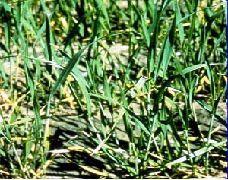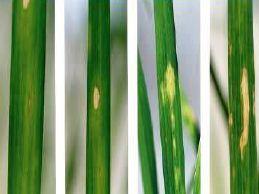Nutritional Deficiencies of Wheat
Nutritional Deficiencies of Wheat
Nitrogen (N)
 Plants are pale green to yellow with chlorosis beginning on lower leaves and progressing upwards as the deficiency intensifies; plants have spindly stems and growth is slow.
Plants are pale green to yellow with chlorosis beginning on lower leaves and progressing upwards as the deficiency intensifies; plants have spindly stems and growth is slow.
Phosphorus (P)
 P deficient plants may remain darker green than normal plants and develop purple discoloration first on the underside and later throughout. Leaf tips may die back when P deficiency is severe. Plants grow slowly, stems are thin and shortened and maturity is delayed. P deficient plants also exhibit poor tillering.
P deficient plants may remain darker green than normal plants and develop purple discoloration first on the underside and later throughout. Leaf tips may die back when P deficiency is severe. Plants grow slowly, stems are thin and shortened and maturity is delayed. P deficient plants also exhibit poor tillering.
Potassium (K)
 K deficiency is initially manifested as chlorosis on the older leaves and progresses upwards as the deficiency intensifies. The leaves eventually become streaked and take on a scorched appearance along the leaf margins. Chlorotic areas may develop throughout the leaf. Deficiency symptoms can occur in young leaves of some fast-maturing high-yielding varieties. Stems of deficient plants are weak and tend to lodge.
K deficiency is initially manifested as chlorosis on the older leaves and progresses upwards as the deficiency intensifies. The leaves eventually become streaked and take on a scorched appearance along the leaf margins. Chlorotic areas may develop throughout the leaf. Deficiency symptoms can occur in young leaves of some fast-maturing high-yielding varieties. Stems of deficient plants are weak and tend to lodge.
Zinc (Zn)
 Zinc deficiency in wheat appears as intervenial chlorosis on the most recently developed leaves; plants are stunted and produce few tillers; if the deficiency is severe the leaves may turn white and die. The most characteristic reactions of wheat plants to zinc deficiency are reductions in plant height and leaf size. These symptoms are followed by the development of whitish-brown necrotic spots on middle-aged leaves. As the severity of zinc deficiency intensifies, the necrotic spots spread on t leaves, and the middle parts of the leaves are often collapsed, showing a “scorched” appearance.
Zinc deficiency in wheat appears as intervenial chlorosis on the most recently developed leaves; plants are stunted and produce few tillers; if the deficiency is severe the leaves may turn white and die. The most characteristic reactions of wheat plants to zinc deficiency are reductions in plant height and leaf size. These symptoms are followed by the development of whitish-brown necrotic spots on middle-aged leaves. As the severity of zinc deficiency intensifies, the necrotic spots spread on t leaves, and the middle parts of the leaves are often collapsed, showing a “scorched” appearance.
Source: NIPHM and Directorate of Plant Protection, Quarantine & Storage
Last Modified : 12/11/2019
This topic provides information about Coffee Nutr...
